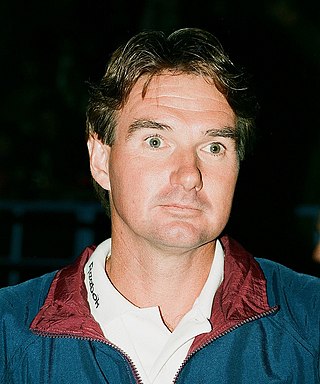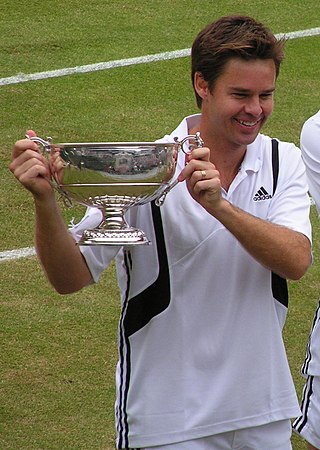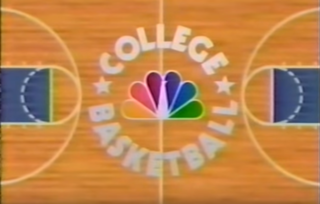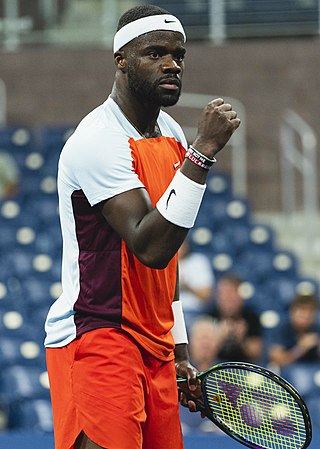Related Research Articles

Björn Rune Borg is a Swedish former world No. 1 tennis player. Between 1974 and 1981, he became the first man in the Open Era to win 11 Grand Slam singles titles with six at the French Open and five consecutively at Wimbledon.

USA Network is an American basic cable television channel owned by the NBCUniversal Media Group division of Comcast's NBCUniversal. It was originally launched in 1977 as Madison Square Garden Sports Network, one of the first national sports cable television channels.

The US Open Tennis Championships, commonly called the US Open, is a hardcourt tennis tournament organized by the United States Tennis Association annually in Queens, New York City. It is chronologically the fourth and final of the four Grand Slam tennis events, held after the Australian Open, French Open, and Wimbledon.
WGN-TV is a television station in Chicago, Illinois, United States, serving as the local outlet for The CW. It is owned and operated by the network's majority owner, Nexstar Media Group, and is sister to the company's sole radio property, news/talk/sports station WGN. WGN-TV's studios are located on West Bradley Place in Chicago's North Center community; as such, it is the only major commercial television station in Chicago which bases its main studio outside the Loop. Its transmitter is located atop the Willis Tower in the Loop.

James Scott Connors is an American former world No. 1 tennis player. He held the top Association of Tennis Professionals (ATP) ranking for a then-record 160 consecutive weeks from 1974 to 1977 and a career total of 268 weeks. By virtue of his long and prolific career, Connors still holds three prominent Open Era men's singles records: 109 titles, 1,557 matches played, and 1,274 match wins. His titles include eight major singles titles and three year-end championships. In 1974, he became the second man in the Open Era to win three major titles in a calendar year, and was not permitted to participate in the fourth, the French Open. Connors finished year end number one in the ATP rankings from 1974 to 1978. In 1982, he won both Wimbledon and the US Open and was ATP Player of the Year and ITF World Champion. He retired in 1996 at the age of 43.
The Grand Slam in tennis is the achievement of winning all four major championships in one discipline in a calendar year. In doubles, a Grand Slam may be achieved as a team or as an individual with different partners. Winning all four major championships consecutively but not within the same calendar year is referred to as a "non-calendar-year Grand Slam", while winning the four majors at any point during the course of a career is known as a "Career Grand Slam".
ESPNews is an American multinational digital cable and satellite television network owned by ESPN Inc., a joint venture between The Walt Disney Company and Hearst Communications.

Todd Andrew Woodbridge, OAM is an Australian broadcaster and former professional tennis player. During his playing career, he formed multiple Grand-Slam winning doubles partnerships with Mark Woodforde and later Jonas Björkman.

The NBA on CBS is the branding that is used for weekly broadcasts of National Basketball Association (NBA) games produced by CBS Sports, the sports division of the CBS television network in the United States. CBS aired NBA games from the 1973–74 NBA season until the 1989–90 NBA season.

Daniel Evans is a British professional tennis player from England. He has been ranked as high as world No. 21 in singles by the ATP, which he achieved on 7 August 2023. He reached a career-high ranking of No. 52 in doubles on 26 April 2021. In 2015, he formed part of the winning British Davis Cup team.
The NHL Network was an American television syndication package that broadcast National Hockey League games from the 1975–76 through 1978–79 seasons. The NHL Network was distributed by the Hughes Television Network.

College Basketball on NBC Sports is the de facto branding used for broadcasts of NCAA Division I men's college basketball games produced by NBC Sports, the sports division of the NBC television network in the United States. The NBC network broadcast college basketball games in some shape or form between 1969 and 1998. From 1969 to 1981, NBC covered the NCAA Division I men's basketball tournament. It became the first major network to broadcast the championship game, at a cost of more than US$500,000 in 1969.

Tennis in Australia refers to the sport of tennis played in Australia. Tennis in Australia has been administered by Tennis Australia since 1904.

PGA Tour on ABC was the de facto branding used for telecasts of the main professional golf tournaments of the PGA Tour on ABC Sports in the United States until 2006. ABC broadcast at least one PGA Tour event from 1962 to 2009, focusing before 1995 on the majors, with ABC serving as the primary television partner of the PGA Tour from 1999 until 2006.
Tennis on CBS is the branding used for broadcasts of professional tennis tournaments that were produced by CBS Sports, the sports division of the CBS television network in the United States. At the time the network's broadcast agreements with the United States Tennis Association (USTA) ended in 2014, CBS held the broadcast rights to the U.S. Open, the U.S. Open Series and the Sony Ericsson Open. From 1980 to 1982, CBS also televised the French Open. CBS also during the 1970s and 1980s, broadcast the Grand Prix tennis circuit. CBS returned to show tennis coverage again after five years, with both World TeamTennis (2019–2020) and USA matches at the Davis Cup (2020–present)
ABC first broadcast selected college basketball games of the now-NCAA Division I during the 1960s and 1970s, before it began televising them on a regular basis on January 18, 1987, with a game between the LSU Tigers and Kentucky Wildcats). As CBS and NBC were also broadcasting college games at the time, this put the sport on all three major broadcast television networks.

Frances Tiafoe Jr. is an American professional tennis player. He reached his career high at world No. 10 in singles on June 19, 2023, becoming the first Sierra Leonean American man to be ranked in the top 10 by the ATP.
The PGA Tour's broadcast television rights are held by CBS Sports and NBC Sports, under contracts most recently renewed in 2021 to last through 2030. While it considered invoking an option to opt out of its broadcast television contracts in 2017, the PGA Tour ultimately decided against doing so. Golf Channel has served as the pay television rightsholder of the PGA Tour since 2007, and its current contract will also expire in 2021. Under the contracts, CBS broadcasts weekend coverage for an average of 20 events per-season, and NBC broadcasts weekend coverage for an average of 10 events per-season. Golf Channel broadcasts early-round and weekend morning coverage of all events, as well as weekend coverage of events not broadcast on terrestrial television, and primetime encores of all events. Tournaments typically featured in NBC's package include marquee events such as The Players Championship, the final three tournaments of the FedEx Cup Playoffs, and the biennial Presidents Cup event. The 2011 contract granted more extensive digital rights, as well as the ability for NBC to broadcast supplemental coverage of events on Golf Channel during its broadcast windows.

When the World Health Organization declared the COVID-19 pandemic in March 2020, all major professional and collegiate organizations responded by suspending operations indefinitely. This effect was passed down to the world of sports broadcasting, which includes live coverage of thousands of events on an annual basis through stations and network available over the air, through cable, satellite, and IPTV companies, and via streaming and over-the-top services.
References
- ↑ Lorge, Barry (March 26, 1978). "Commercial Stations Latch Onto, Chop Up Summer Tennis". Washington Post.
- ↑ "GRAND PRIX TENNIS". Sarasota Journal. March 17, 1978. Retrieved April 18, 2024.
- ↑ Harrison, Bernie (August 28, 1978). "The Sports Beat". The Times-News. Retrieved April 18, 2024.
- ↑ "THE SPORTS BEAT". Lakeland Ledger. August 28, 1978.